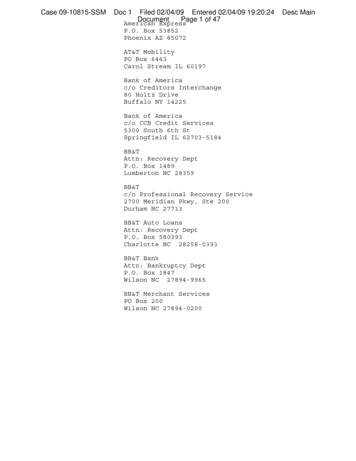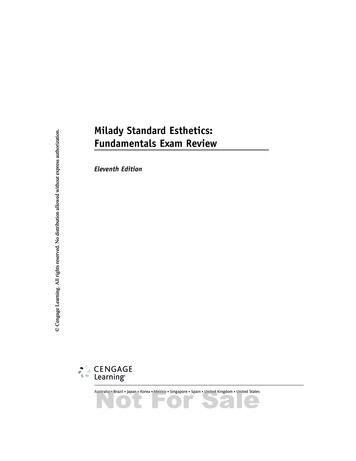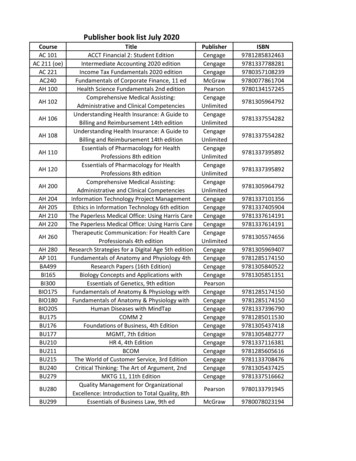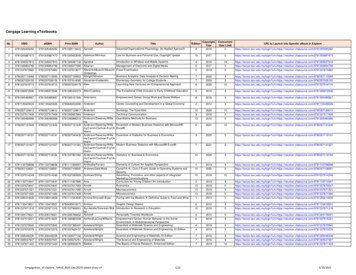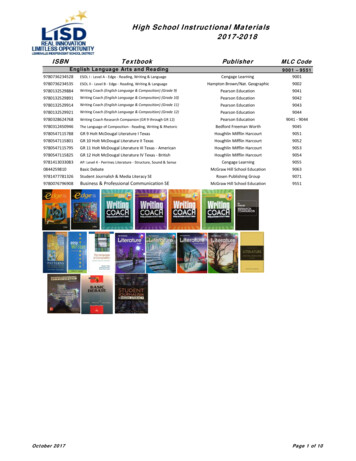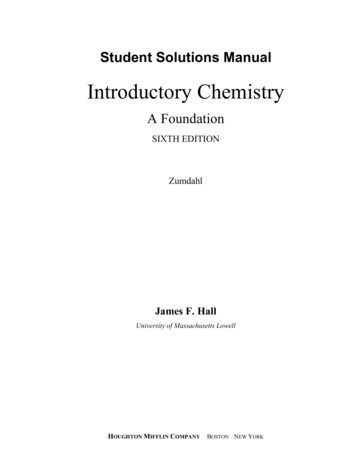
Transcription
Student Solutions ManualIntroductory ChemistryA FoundationSIXTH EDITIONZumdahlJames F. HallUniversity of Massachusetts LowellHOUGHTON MIFFLIN COMPANY BOSTON NEW YORK
Vice President and Publisher: Charles HartfordDevelopment Editor: Bess DeckEditorial Associate: Chip CheekEditorial Assistant: Katherine RozProduction Coordinator: Sean McGannAncillary Producer: Brett PasinellaMarketing Manager: Laura McGinnMarketing Assistant: Kris BishopCopyright 2008 by Houghton Mifflin Company. All rights reserved.No part of this work may be reproduced in any form or by any means, electronic or mechanical,including photocopying and recording, or by any information storage or retrieval system without theprior written permission of Houghton Mifflin Company unless such copying is expressly permitted byfederal copyright law. Address inquiries to College Permissions, Houghton Mifflin Company, 222Berkeley Street, Boston, MA 02116-3764.Printed in the U.S.A.ISBN-10: 0-618-80334-3ISBN-13: 978-0-618-80334-7123456789-XX-11 10 09 08 07
ContentsPREFACE. VCHAPTER 1 – CHEMISTRY: AN INTRODUCTION . 1CHAPTER 2 – MEASUREMENTS AND CALCULATIONS . 2CHAPTER 3 – MATTER . 14CUMULATIVE REVIEW CHAPTERS 1–3 . 17CHAPTER 4 – CHEMICAL FOUNDATIONS: ELEMENTS, ATOMS, AND IONS . 21CHAPTER 5 – NOMENCLATURE. 29CUMULATIVE REVIEW CHAPTERS 4 & 5 . 37CHAPTER 6 – CHEMICAL REACTIONS: AN INTRODUCTION . 41CHAPTER 7 – REACTIONS IN AQUEOUS SOLUTION . 45CUMULATIVE REVIEW CHAPTERS 6 & 7 . 55CHAPTER 8 – CHEMICAL COMPOSITION . 59CHAPTER 9 – CHEMICAL QUANTITIES . 84CUMULATIVE REVIEW CHAPTERS 8 & 9 . 105CHAPTER 10 – ENERGY . 110CHAPTER 11 – MODERN ATOMIC THEORY . 116CHAPTER 12 – CHEMICAL BONDING . 123CUMULATIVE REVIEW CHAPTERS 10–12. 135CHAPTER 13 – GASES . 141CHAPTER 14 – LIQUIDS AND SOLIDS . 157CHAPTER 15 – SOLUTIONS . 163CUMULATIVE REVIEW CHAPTERS 13–15. 180CHAPTER 16 – ACIDS AND BASES. 187CHAPTER 17 – EQUILIBRIUM . 195CUMULATIVE REVIEW CHAPTERS 16 & 17 . 203CHAPTER 18 – OXIDATION–REDUCTION REACTIONS/ELECTROCHEMISTRY . 209CHAPTER 19 – RADIOACTIVITY AND NUCLEAR ENERGY . 219CHAPTER 20 – ORGANIC CHEMISTRY . 224CHAPTER 21 – BIOCHEMISTRY . 235Copyright Houghton Mifflin Company. All rights reserved.
PrefaceThis guide contains the even-numbered solutions for the end-of-chapter problems in the sixth editionsof Introductory Chemistry, Introductory Chemistry: A Foundation, and Basic Chemistry by Steven S.Zumdahl. Several hundred new problems and questions have been prepared for the new editions of thetext, which we hope will be of even greater help to your students in gaining an understanding of thefundamental principles of chemistry.We have tried to give the most detailed solutions possible to all the problems even though someproblems give repeat drill practice on the same subject. Our chief attempt at brevity is to give molarmasses for compounds without showing the calculation (after the subject of molar mass itself has beendiscussed). We have also made a conscious effort in this guide to solve each problem in the mannerdiscussed in the textbook. The instructor, of course, may wish to discuss alternative methods of solutionwith his or her students.One topic that causes many students concern is the matter of significant figures and the determinationof the number of digits to which a solution to a problem should be reported. To avoid truncation errorsin the solutions contained in this guide, the solutions typically report intermediate answers to one moredigit than appropriate for the final answer. The final answer to each problem is then given to the correctnumber of significant figures based on the data provided in the problem.Many very dedicated people have worked long hours to prepare this guide. Particular thanks go to BessDeck, Liz Hogan and Sean McGann at Houghton Mifflin for their patience, competence, and goodcheer.James F. HallUniversity of Massachusetts LowellJames Hall@uml.eduCopyright Houghton Mifflin Company. All rights reserved.
CHAPTER 1Chemistry: An IntroductionCHAPTER ANSWERS2.The answer will depend on student examples.4.Answer depends on student response.6.This answer depends on your own experience, but consider the following examples: oven cleaner(the label says it contains sodium hydroxide; it converts the burned-on grease in the oven to asoapy material that washes away); drain cleaner (the label says it contains sodium hydroxide; itdissolves the clog of hair in the drain); stomach antacid (the label says it contains calciumcarbonate; it makes me belch and makes my stomach feel better); hydrogen peroxide (the labelsays it is a 3% solution of hydrogen peroxide; when applied to a wound, it bubbles); depilatorycream (the label says it contains sodium hydroxide; it removes unwanted hair from skin).8.The scientist must recognize the problem and state it clearly, propose possible solutions orexplanations, and then decide through experimentation which solution or explanation is best.10. Answer depends on student response. A quantitative observation must include a number. Forexample, “There are two windows in this room.” represents a quantitative observation, but, “Thewalls of this room are yellow.” is a qualitative observation.12. A natural law is a summary of observed, measurable behavior that occurs repeatedly andconsistently. A theory is our attempt to explain such behavior. The conservation of mass observedduring chemical reactions is an example of a natural law. The idea that the universe began with a“big bang” is an example of a theory.14. Chemistry is not just a set of facts that have to be memorized. To be successful in chemistry, youhave to be able to apply what you have learned to new situations, new phenomena, and newexperiments. Rather than just learning a list of facts or studying someone else’s solution to aproblem, your instructor hopes you will learn how to solve problems yourself, so that you will beable to apply what you have learned in future circumstances.16. In real-life situations, the problems and applications likely to be encountered are not simpletextbook examples. One must be able to observe an event, hypothesize a cause, and then test thehypothesis. One must be able to carry what has been learned in class forward to new, differentsituations.Copyright Houghton Mifflin Company. All rights reserved.
CHAPTER 2Measurements and CalculationsCHAPTER ANSWERS2.“Scientific notation” means we have to put the decimal point after the first significant figure andthen express the order of magnitude of the number as a power of ten. So we want to put thedecimal point after the first two:63.5 g125 cm3To be able to move the decimal point three places to the left in going from 2,421 to 2.421, means Iwill need a power of 103 after the number, where the exponent three shows that I moved thedecimal point three places to the left.2, 421 2.421 10to some power 2.421 1034.If the number is greater than one, the exponent is positive; if the number is less than one, theexponent is .already a decimal numberb.The decimal point must be moved three places to the right: 1995c.The decimal point must be moved two places to the right: 199.5d.The decimal point must be moved four places to the left: 0.0001995a.The decimal point has to be moved three places to the right, so the exponent will be 3.b.The decimal point has to be moved four places to the left, so the exponent will be –4.c.The decimal point has to be moved two places to the right, so the exponent will be 2.d.This number is already written as a power of ten but is not in standard scientific notation;realizing that 0.994 9.94 101 and combining exponents gives the final exponent as 1.a.five spaces to the rightb.three spaces to the leftc.eight spaces to the left6.8.10.Copyright Houghton Mifflin Company. All rights reserved.
Chapter 2: Measurements and Calculationsd.three spaces to the righta.The decimal point must be moved four places to the left: 0.0004915.b.The decimal point must be moved three spaces to the right: 994.c.The decimal point must be moved three spaces to the left: 0.02495.d.already a decimal numbere.The decimal point must be moved two spaces to the right: 693.4.f.The decimal point must be moved one space to the right: 693.4.a.1/0.00032 3.1 103b.103/10–3 1 106c.103/103 1 (1 100); any number divided by itself is unity.d.1/55,000 1.8 10–5e.(105)(104)(10–4)/10–2 1 107f.43.2/(4.32 10–5) 4.32 101 1.00 106-54.32 10g.(4.32 10–5)/432 4.32 10-5 1.00 10–724.32 10h.1/(105)(10–6) 1/(10–1) 1 10112.14.16. 0. Since a pound is 453.6 g, the 125-g can will be slightly less than ¼ pound.22. Since 1 in 2.54 cm, the nail is approximately an inch long.24. Since a liter is slightly more than a quart, the 2–L bottle is larger.26. 1.62 m is approximately 5 ft, 4 in. The woman is slightly taller.28.a.centimeterb.meterCopyright Houghton Mifflin Company. All rights reserved.3
4Chapter 2: Measurements and Calculationsc.kilometer30. d (The other units would give very large numbers for the distance.)32. Table 2.6 indicates that a nickel coin weighs about 5 g; 1 kg 1000 g: so1000 g about 200 nickels.5 g/nickel34. uncertainty36. The scale of the ruler shown is marked only to the nearest tenth of a centimeter; writing 2.850would imply that the scale was marked to the nearest hundredth of a centimeter (and that the zeroin the thousandths place had been estimated).38.a.oneb.infinite (definition)c.infinite (fixed number)d.twoe.probably two40. It is better to round off only the final answer and to carry through extra digits in intermediatecalculations. If there are enough steps to the calculation, rounding off in each step may lead to acumulative error in the final answer.42.a.9.96 10–1b.4.40 103c.8.22 10–1d.4.00 10–9e.8.42 10–2a.8.8 10–4b.9.375 104c.8.97 10–1d.1.00 10344.46. The total mass would be determined by the number of decimal places available on the readout ofthe scale/balance. For example, if a balance whose readout is to the nearest 0.01 g were used, thetotal mass would be reported to the second decimal place. For example, 32.05 g 29.15 g 31.09g would be reported as 92.29 g to the second decimal place. For the calculation 44.05 g 33.91 g 48.38 g, the sum would be reported as 126.34 g (a total of five significant figures, but given tothe second decimal place).48. Most calculators would display 0.66666666. If the 2 and 3 were experimentally determinednumbers, this quotient would imply far too many significant figures.50. noneCopyright Houghton Mifflin Company. All rights reserved.
Chapter 2: Measurements and Calculations552.a.5.16 (The answer can be given only to the second decimal place because 3.04 is known onlyto the second decimal place.)b.2423 (2.423 103; the numbers have to be expressed in the same power of 10 before adding2119 304 2423)c.0.516 (5.159 10–1; both numbers are the same power of 10)d.2423 (This is the same problem as part b only the numbers were not expressed in scientificnotation.)a.one (the factor of two has only one significant figure)b.four (the sum within the parentheses will contain four significant figures)c.two (based on the factor 4.7 10–6 having only two significant figures)d.three (based on the factor 63.9 having only three significant figures)a.(2.0944 0.0003233 12.22)/7.001 (14.3147233)/7.001 2.045b.(1.42 102 1.021 103)/(3.1 10–1) 54.56.(142 1021)/(3.1 10–1) (1163)/(3.1 10–1) 3751 3.8 103c.(9.762 10–3)/(1.43 102 4.51 101) (9.762 10–3)/(143 45.1) (9.762 10–3)/(188.1) 5.19 10–5d.(6.1982 10–4)2 (6.1982 10–4)(6.1982 10–4) 3.8418 10–758. an infinite number (a definition)60.1000 mL1Land1L1000 mL62.1 lb 0.7964.a.2.23 m 1.094 yd 2.44 yd1mb.46.2 yd 1m 42.2 m1.094 ydc.292 cm 1 in 115 in2.54 cmd.881.2 in 2.54 cm 2238 cm1 ine.1043 km 1 mi 648.1 mi1.6093 kmCopyright Houghton Mifflin Company. All rights reserved.
6Chapter 2: Measurements and Calculations1.6093 km 716.9 km1 mif.445.5 mi g.36.2 m h.0.501 km a.5.25 oz b.125 g 1 lb 0.276 lb453.59 gc.125 g 1 lb16 oz 4.41 oz1 lb453.59 gd.125 mL 1L 0.125 L1000 mLe.125 mL 1.057 qt 2 pt 0.264 pt 1000 mL 1 qtf.2.5 mi 1.6093 km 4.0 km1 mig.2.5 mi 1.6093 km 1000 m 4.0 103 m1 mi1 kmh.2.5 mi 1.6093 km 1000 m 100 cm 4.0 105 cm1 mi1 km1m1 km 0.0362 km1000 m1000 m100 cm 5.01 104 cm1 km1m66.1 lb 0.328 lb16 oz68. 190 mi 1.9 102 mi to two significant figures1.9 102 mi 1 km 3.1 102 km0.62137 mi3.1 102 km 1000 m 3.1 105 m1 km1.9 102 mi 5280 ft 1.0 106 ft1 mi70. 1 10–10 m 100 cm 1 10–8 cm1m1 10–8 cm 1 in 4 10–9 in.2.54 cm1 10–8 cm 1m109 nm 0.1 nm100 cm1mCopyright Houghton Mifflin Company. All rights reserved.
Chapter 2: Measurements and Calculations72. freezing74. 27376. Fahrenheit (F)78.80.82.TC TK 273a.–210 273 63 Kb.275 K – 273 2ºCc.778 K – 273 505ºCd.778 273 1051 KTF 1.80(TC ) 32a.1.80(78.1) 32 173ºFb.1.80(40.) 32 104ºFc.1.80(–273) 32 –459ºFd.1.80(32) 32 90.ºFTF 1.80(TC ) 32TC (TF 32)/1.80a.275 – 273 2ºCb.(82 – 32)/1.80 28ºCc.1.80(–21) 32 –5.8ºF (–6ºF)d.(–40 – 32)/1.80 –40 ºC (the Celsius and Fahrenheit temperatures are the same).84. g/cm3 (g/mL)86. 100 in388. Density is a characteristic property that is always the same for a pure substance.90. copper92. density massvolume122.4 g 22 g/cm335.5 cma.d b. 100 cm 53v 0.57 m3 5.7 10 cm 1m 3d c.1.9302 104 g 0.034 g/cm355.7 10 cmm 0.0175 kg 1000 g 17.5 g1 kgCopyright Houghton Mifflin Company. All rights reserved.7
8Chapter 2: Measurements and Calculationsd 17.5 g 0.962 g/mL 0.962 g/cm318.2 mL3d. 100 cm 53v 0.12 m3 1.2 10 cm 1m d 2.49 g 2.1 10–5 g/cm31.2 105 cm 394. 1.0 kg 1.0 103 g1.0 103 g 96. m 3.5 lb 1 mL 0.91 L (two significant figures)1.097 g453.59 g 1.59 103 g1 lb3 2.54 cm 53v 1.2 104 in.3 1.97 10 cm1in d 1.59 103 g 8.1 10–3 g/cm3531.97 10 cmThe material will float.98. 5.25 g 1 cm3 0.500 cm3 0.500 mL10.5 g11.2 mL 0.500 mL 11.7 mL100.a.50.0 cm3 19.32 g 966 g1 cm3b.50.0 cm3 7.87 g 394 g1 cm3c.50.0 cm3 11.34 g 567 g1 cm3d.50.0 cm3 2.70 g 135 g1 cm 3a.3.011 1023 301,100,000,000,000,000,000,000b.5.091 109 5,091,000,000c.7.2 102 720d.1.234 105 123,400e.4.32002 10–4 0.000432002f.3.001 10–2 0.03001102.Copyright Houghton Mifflin Company. All rights reserved.
Chapter 2: Measurements and Calculationsg.2.9901 10–7 0.00000029901h.4.2 10–1 e.millimetersa.36.2 blim 1400 kryll 5.07 104 kryll1 blimb.170 kryll 1 blim 0.12 blim1400 kryllc. 1 blim –5272.5 kryll 3.70 10 blim 1400 kryll 104.106.22108. 52 cm 110. 1 lb 1 in 20. in2.54 cm1 kg 1.20 2.45euro 1.33 per pound2.2 lb 1 euro1 kg112. X 1.26 C 14114. d 36.8 g 3.50 g/L (3.50 10–3 g/cm3)10.5 L116. For ethanol, 100. mL 0.785 g 78.5 g1 mLFor benzene, 1000 mL 0.880 g 880. g1 mLtotal mass, 78.5 880. 959 eCopyright Houghton Mifflin Company. All rights reserved.9
10Chapter 2: Measurements and Calculations120.a.2; positiveb.11; negativec.3; positived.5; negativee.5; positivef.0; zerog.1; negativeh.7; negativea.1; positiveb.3; negativec.0; zerod.3; positivee.9; negativea.The decimal point must be moved five places to the left; 2.98 10–5 0.0000298.b.The decimal point must be moved nine places to the right; 4.358 109 4,358,000,000.c.The decimal point must be moved six places to the left; 1.9928 10–6 0.0000019928.d.The decimal point must be moved 23 places to the right; 6.02 1023 602,000,000,000,000,000,000,000.e.The decimal point must be moved one place to the left; 1.01 10–1 0.101.f.The decimal point must be moved three places to the left; 7.87 10–3 0.00787.g.The decimal point must be moved seven places to the right; 9.87 107 98,700,000.h.The decimal point must be moved two places to the right; 3.7899 102 378.99.i.The decimal point must be moved one place to the left; 1.093 10–1 0.1093.j.The decimal point must be moved zero places; 2.9004 100 2.9004.k.The decimal point must be moved four places to the left; 3.9 10–4 0.00039.l.The decimal point must be moved eight places to the left; 1.904 10–8 0.00000001904.a.1/102 1 10–2b.1/10–2 1 102c.55/103 122.124.126.5.5 101 5.5 10–21 103Copyright Houghton Mifflin Company. All rights reserved.
Chapter 2: Measurements and Calculationsd.(3.1 106)/10–3 e.(106)1/2 1 103f.(106)(104)/(102) g.1/0.0034 h.3.453/10–4 113.1 106 3.1 1091 10 3(1 106 )(1 104 ) 1 108(1 102 )1 2.9 102-33.4 103.453 3.453 1041 10-4128. Kelvin, K130. centimeter132. 0.105 m134. 1 kg (100 g 0.1 kg)136. 10 cm (1 cm 10 mm)138. 2.8 (the hundredths place is estimated)140.a.0.000426b.4.02 10–5c.5.99 106d.400.e.0.00600a.2149.6 (The answer can be given only to the first decimal place because 149.2 is knownonly to the first decimal place)b.5.37 103 (The answer can be given only to two decimal places because 4.34 is known onlyto two decimal places. Moreover, since the power of ten is the same for each number, thecalculation can be performed directly.)c.Before performing the calculation, the numbers have to be converted so that they contain thesame power of ten.142.4.03 10–2 – 2.044 10–3 4.03 10–2 – 0.2044 10–2 3.83 10–2 (The answer can begiven only to the second decimal place because 4.03 10–2 is known only to the seconddecimal place.)d.Before performing the calculation, the numbers have to be converted so that they contain thesame power of ten.2.094 105 – 1.073 106 2.094 105 – 10.73 105 –8.64 105Copyright Houghton Mifflin Company. All rights reserved.
12Chapter 2: Measurements and Calculations144.a.(2.9932 104)(2.4443 102 1.0032 101) (2.9932 104)(24.443 101 1.0032 101) (2.9932 104)(25.446 101) 7.6166 106b.(2.34 102 2.443 10–1)/(0.0323) (2.34 102 0.002443 102)/(0.0323) (2.34 102)/(0.0323) 7.24 103146.c.(4.38 10–3)2 1.92 10–5d.(5.9938 10–6)1/2 2.4482 10–31 year12 months;12 months1 year148.a.908 oz 1 lb1 kg 25.7 kg16 oz 2.2046 lbb.12.8 L 1 qt1 gal 3.38 gal 0.94633 L 4 qtc.125 mL 1L1 qt 0.132 qt1000 mL 0.94633 Ld.2.89 gal 4 qt1L1000 mL 1.09 104 mL 1 gal 1.0567 qt1Le.4.48 lb 453.59 g 2.03 103 g1 lbf.550 mL 1L1.0567 qt 0.58 qt1000 mL1L150. Assuming exactly 6 gross, 864 pencils152.a.Celsius temperature (175 – 32)/1.80 79.4 CKelvin temperature 79.4 273 352 Kb.255 – 273 –18 Cc.(–45 – 32)/1.80 –43 Cd.1.80(125) 32 257 F154. 85.5 mL 0.915 g 78.2 g1 mLCopyright Houghton Mifflin Company. All rights reserved.
Chapter 2: Measurements and Calculations156. m 155 lb 453.59 g 7.031 104 g1 lb33 12 in 2.54 cm 53v 4.2 ft3 1.189 10 cm 1 ft 1 in d 7.031 104 g 0.59 g/cm31.189 105 cm3158. TF 1.80(TC ) 32a.23 Fb.32 Fc.–321 Fd.–459 Fe.187 Ff.–459 FCopyright Houghton Mifflin Company. All rights reserved.13
CHAPTER 3MatterCHAPTER ANSWERS2.forces4.liquids6.gaseous8.The stronger the interparticle forces, the more rigid is the sample overall.10. Gases are easily compressed into smaller volumes whereas solids and liquids are not. Because agaseous sample consists mostly of empty space, it is the empty space that is compressed whenpressure is applied to a gas.12. This is a chemical change; the mercury disappears and is replaced by an orange solid.14. Magnesium is malleable and ductile.16. The most common physical changes are changes in state: solid to liquid, liquid to gaseous, solid togaseous (and their opposites).18.a.physical: The iron is only being heated.b.chemical: The sugars in the marshmallow are being reduced to carbon.c.chemical: Most strips contain a peroxide that decomposes.d.chemical: The bleach oxidizes dyes in the fabric.e.physical: Evaporation is only a change of state.f.physical: The salt is modifying only the physical properties of the solution, not undergoing achemical reaction.g.chemical: The drain cleaner breaks bonds in the hair.h.physical: Students will most likely reply that this is a physical change since the perfume isevaporating; the sensation of smell, however, depends on chemical processes.i.physical: The sublimation is only a change of state.j.physical: The wood is only being physically divided into smaller pieces.k.chemical: The cellulose in the wood is reacting with oxygen gas.20. Compounds consist of two or more elements combined together chemically in a fixedcomposition, no matter what their source may be. For example, water on earth consists ofmolecules containing one oxygen atom and two hydrogen atoms. Water on Mars (or any otherplanet) has the same composition.22. compoundsCopyright Houghton Mifflin Company. All rights reserved.
Chapter 3: Matter1524. Typically, the properties of a compound and the elements that constitute it are very different.Consider the properties of liquid water and the hydrogen and oxygen gases from which the waterwas prepared. Consider the properties of sodium chloride (table salt) and the sodium metal andchlorine gas from which it might have been prepared.26. Assuming the magnesium and sulfur had been measured out in exactly the correct ratio forcomplete reaction, what would remain after heating would be a pure compound. If there were anexcess of either magnesium or sulfur, however, the material left after reaction would be a mixtureof the compound and the excess reagent.28. solutions: window cleaner, shampoo, rubbing alcoholmixtures: salad dressing, jelly beans, the change in my pocket30.a.primarily a pure compound, but fillers and anti-caking agents may have been addedb.mixturec.mixtured.pure usd.heterogeneouse.homogeneous32.34. Consider a mixture of salt (sodium chloride) and sand. Salt is soluble in water, sand is not. Themixture is added to water, stirred to dissolve the salt and then filtered. The salt solution passesthrough the filter; the sand remains on the filter. The water can then be evaporated from the salt.36. The solution is heated to vaporize (boil) the water. The water vapor is then cooled so that itcondenses back to the liquid state, and the liquid is collected. After all the water is vaporized fromthe original sample, pure sodium chloride will remain. The process consists of physical changes.38. Since X is a pure substance, the fact that two different solids form when electrical current ispassed indicates that X must be a compound.40. Because vaporized water is still the same substance as solid water, no chemical reaction hasoccurred. Sublimation is a physical change.42. far apart44. chemical46. chemical48. ight Houghton Mifflin Company. All rights reserved.
16Chapter 3: Matterc.heterogeneous (Unless you work hard to get all the lumps out!)d.Although strictly heterogeneous, it may appear homogeneous.e.heterogeneous52. Answer depends on student’s response54. physical, chemical56. O2 and P4 are both still elements, even though the ordinary forms of these elements consist ofmolecules containing more than one atom (but all atoms in each respective molecule are thesame). P2O5 is a compound because it is made up of two or more different elements (not all theatoms in the P2O5 molecule are the same).58. Assuming there is enough water present in the mixture to have dissolved all the salt, filter themixture to separate out the sand from the mixture. Then distill the filtrate (consisting of salt andwater), which will boil off the water, leaving the salt.60. The most obvious difference is the physical states: Water is a liquid under room conditions;hydrogen and oxygen are both gases. Hydrogen is flammable. Oxygen supports combustion.Water does neither.Copyright Houghton Mifflin Company. All rights reserved.
Cumulative Review Chapters 1–3ANSWERS2.By now, after having covered three chapters in this book, it is hoped that you have adopted an“active” approach to your study of chemistry. You may have discovered, perhaps through adisappointing grade on a quiz (though we hope not), that you have to get really involved withchemistry. You can’t just sit and take notes or just look over the solved examples in the textbook.You have to learn to solve problems. You have to learn how to interpret problems and how toreduce them to the simple mathematical relationships you have studied. Whereas in some coursesyou might get by on just giving back on exams the facts or ideas presented in class, in chemistryyou have to be able to extend and synthesize what has been discussed and to apply the material tonew situations. Don’t get discouraged if this is difficult at first: it’s difficult for everyone at first.4.It is difficult sometimes for students (especially beginning students) to understand why certainsubjects are required for a given college major. The faculty of your major department, however,have collectively many years of experience in the subject in which you have chosen to specialize.They really do know which courses will be helpful to you in the future. They may have hadtrouble with the same courses that now give you trouble, but they realize that all the work will beworth it in the end. Some courses you take, particularly in your major field itself, have obviousand immediate utility. Other courses, oftentimes chemistry included, are provided to give you ageneral background knowledge that may prove useful in understanding your own major or othersubjects related to your major. In perhaps a burst of bravado, chemistry has been called “thecentral science” by one team of textbook authors. This moniker is very true; however, in order tounderstand biology, physics, nutrition, farming, home economics, or whatever, it helps to have ageneral background in chemistry.Commonly Used Prefixes in the Metric SystemPrefixMeaningPower of The metric system is in use in most of the world because its system of units and multiples issimple to remember, and the system permits easy conversion between units. The various multiplesand subdivisions of the basic units are based on factors of ten, which are also the basis for ournumber system. The United States uses a historical system in which there is no simplerelationship among most units. Although several attempts have been made to gradually change theUnited States over to the metric system, no widespread support for the program has beenachieved. Although 2-liter soda bottles were accepted without too much complaint (since theyCopyright Houghton Mifflin Company. All rights reserved.
18Cumulative Review Chapters 1–3replaced a similar-sized 2-quart bottle), the thought of having a size 85 waist (in cm) may berepugnant to too many Americans! There obviously also would be a great cost to industry toretool all machinery and measurement devices in metric units.6.Whenever a scientific measurement is made, we always employ the instrument or measuringdevice we are using t
of Introductory Chemistry, Introductory Chemistry: A Foundation, and Basic Chemistry by Steven S. Zumdahl. Several hundred new problems and questions have been prepared for the new editions of the text, which we hope will be of even greater help to your students in gaining an

